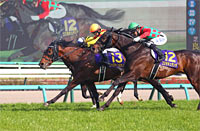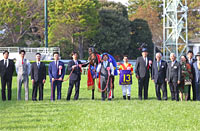Satsuki Sho (Japanese 2000 Guineas) (G1) - Data Analysis
Three-year-olds to clash in first leg of Classic Triple Crown
In 2020, Contrail swept the Triple Crown races with an unbeaten record in a feat that is still fresh in our memory today. In 2021, the Satsuki Sho (Japanese 2000 Guineas) was won by Efforia, who went on to defeat older runners in the Tenno Sho (Autumn) and the Arima Kinen (The Grand Prix) of the same year, and was voted JRA’s Horse of the Year. Let’s now look for some trends in this highly-anticipated first leg of the Triple Crown, which attracts the top runners of this generation, based on results over the last 10 years.
Dark horses cannot be ruled out
Looking at performances by runners over the last 10 years in terms of favoritism, we find that highly favored runners have continually produced winners in recent years, with 2019 winner Saturnalia and 2020 winner Contrail being backed as 1st favorites, and 2021 winner Efforia as 2nd favorite. However, the winners from 2016 to 2018 were all backed as 7th favorite or lower, and even in years when highly favored runners notched the win, we find that dark horses edged into the Top 3. For example, third-place finisher Galore Creek in 2020 and runner-up Titleholder in 2021 were both backed as 8th favorite. Runners backed as 10th favorite or lower only produced one third-place finisher, suggesting we can safely dismiss such runners. However, we would do well not to overlook runners backed as 6th-9th favorite. [Table 1]
[Table 1] Performance by favoritism (last 10 years)
| Favoritism |
Performance
[1st-2nd-3rd-4th or lower] |
Win ratio |
Top 2 ratio |
Top 3 ratio |
| 1st favorite |
3-1-1-5 |
30.0% |
40.0% |
50.0% |
| 2nd favorite |
2-3-0-5 |
20.0% |
50.0% |
50.0% |
| 3rd favorite |
1-2-3-4 |
10.0% |
30.0% |
60.0% |
| 4th favorite |
1-2-1-6 |
10.0% |
30.0% |
40.0% |
| 5th favorite |
0-0-0-10 |
0% |
0% |
0% |
| 6th-9th favorite |
3-2-4-31 |
7.5% |
12.5% |
22.5% |
| 10th favorite or lower |
0-0-1-82 |
0% |
0% |
1.2% |
Watch previous race and finish in that race
Looking at performances by runners over the last 10 years in terms of the previous race, we note that five winners, including Efforia, had previously contested the Kyodo News Hai (Tokinominoru Kinen). In recent years, we have also seen strong performance by runners coming straight from a G1 race for two-year-olds. For example, Saturnalia and Contrail both came from the Hopeful Stakes and triumphed in the Satsuki Sho. The Hopeful Stakes is contested on the same 2,000m turf course at Nakayama Racecourse, so it would be reasonable to assume that a favorable performance in the Hopeful Stakes would bode well for success in the Satsuki Sho. However, runners coming from the Hochi Hai Yayoi Sho (Deep Impact Kinen) (Japanese 2000 Guineas Trial), which is also held on the same course, have surprisingly struggled to deliver a winner. We should also take into account the increase in strong performers coming from non-trial races in recent years. [Table 2]
[Table 2] Performance by previous race (last 10 years)
| Previous race |
Performance
[1st-2nd-3rd-4th or lower] |
Win ratio |
Top 2 ratio |
Top 3 ratio |
| Kyodo News Hai (Tokinominoru Kinen) |
5-0-2-8 |
33.3% |
33.3% |
46.7% |
| Spring Stakes |
2-1-3-33 |
5.1% |
7.7% |
15.4% |
| Hopeful Stakes |
2-0-0-1 |
66.7% |
66.7% |
66.7% |
| Mainichi Hai |
1-0-0-9 |
10.0% |
10.0% |
10.0% |
| Hochi Hai Yayoi Sho (Japanese 2000 Guineas Trial) |
0-5-2-32 |
0% |
12.8% |
17.9% |
| Asahi Hai Futurity Stakes |
0-1-0-1 |
0% |
50.0% |
50.0% |
| JRA graded race other than the above |
0-1-2-15 |
0% |
5.6% |
16.7% |
| Wakaba Stakes |
0-2-1-21 |
0% |
8.3% |
12.5% |
| Other race |
0-0-0-23 |
0% |
0% |
0% |
Note: Data for the Hopeful Stakes includes years during which the race was held as a G2 race.
Note: Data for the Wakaba Stakes includes years before and after the race was held as a listed race.
In addition, looking at performances in terms of the finish in the previous race, 25 of the 30 Top 3 finishers over the last 10 years had finished in the Top 2 of their previous race. Among the five runners that had been beaten to 3rd or lower in their previous race but still finished in the Top 3 of the Satsuki Sho, four had finished 3rd or 4th in the Hochi Hai Yayoi Sho last time out, and the remaining runner had finished 5th in the Kyodo News Service Hai. In other words, all of these runners had finished in the Top 5 of a major prep race. We should discount runners that have been beaten to 3rd or lower in other races. [Table 3]
[Table 3] Performance by finish in previous race (last 10 years)
| Finish in previous race |
Performance
[1st-2nd-3rd-4th or lower] |
Win ratio |
Top 2 ratio |
Top 3 ratio |
| 1st |
8-7-5-50 |
11.4% |
21.4% |
28.6% |
| 2nd |
2-1-2-28 |
6.1% |
9.1% |
15.2% |
| 3rd |
0-0-2-21 |
0% |
0% |
8.7% |
| 4th |
0-2-0-13 |
0% |
13.3% |
13.3% |
| 5th |
0-0-1-5 |
0% |
0% |
16.7% |
| 6th or lower |
0-0-0-26 |
0% |
0% |
0% |
Focus on runners that have achieved a Top 2 finish in a JRA graded race
Of the 30 Top 3 finishers over the last 10 years, 28 had experience of finishing in the Top 2 of a JRA graded race. When making our predictions, we should therefore focus on runners that have achieved a Top 2 finish in a previous JRA graded race. In addition, the remaining two Top 3 finishers had contested a previous JRA graded race and finished 4th, making it into the Top 5 of such a race. Runners that entered the Satsuki Sho without having contested a previous JRA graded race struggled with performance of [0-0-0-24]. This suggests the Satsuki Sho is not conducive to strong performance by runners that are competing for the first time in a graded race, validating its status as a Classic race. [Table 4]
[Table 4] Performance by Top 2 experience in JRA graded races (last 10 years)
Experience |
Performance
[1st-2nd-3rd-4th or lower] |
Win ratio |
Top 2 ratio |
Top 3 ratio |
| Yes |
10-8-10-88 |
8.6% |
15.5% |
24.1% |
| No |
0-2-0-55 |
0% |
3.5% |
3.5% |
Check performances in open-class 1,800m turf races
The last 10 winners all had experience of finishing in the Top 2 of an open-class 1,800m turf race. Runners with such experience also achieved a fairly high Top 3 ratio of 31.4%. While the Hopeful Stakes (G1) and the Hochi Hai Yayoi Sho (both held on the same course as the Satsuki Sho) generally attract much of the attention, we should also check runners’ track record in open-class turf 1,800m races. [Table 5]
[Table 5] Performance by experience of finishing in Top 2 of open-class 1,800m turf race (last 10 years)
| Experience |
Performance
[1st-2nd-3rd-4th or lower] |
Win ratio |
Top 2 ratio |
Top 3 ratio |
| Yes |
10-5-7-48 |
14.3% |
21.4% |
31.4% |
| No |
0-5-3-95 |
0% |
4.9% |
7.8% |
Seek out the winner!
Runners with shorter careers have fared well in recent years
Among the winners since 2015, four had won a newcomer race, and three had been defeated in a newcomer race but won a maiden race. Setting aside their performance in their racing debut, all seven winners had triumphed in the race following their first win. Thanks to the consecutive wins, the seven winners secured some leeway in their racing schedule, and entered the Satsuki Sho with four or fewer career starts. By factoring this information into our analysis along with the trends shown in Table 4 and Table 5, we should be able to single out likely win contenders. [Table 6]
[Table 6] Winners’ total career starts and race following first win (last seven years)
| Year |
Winner |
Total career starts |
Race following first win |
| 2015 |
Duramente |
4 |
Saintpaulia Sho, 1st |
| 2016 |
Dee Majesty |
4 |
Kyodo News Hai (Tokinominoru Kinen), 1st |
| 2017 |
Al Ain |
4 |
Senryo Sho, 1st |
| 2018 |
Epoca d'Oro |
4 |
Asunaro Sho, 1st |
| 2019 |
Saturnalia |
3 |
Hagi Stakes, 1st |
| 2020 |
Contrail |
3 |
Tokyo Sports Hai Nisai Stakes, 1st |
| 2021 |
Efforia |
3 |
Hyakunichiso Tokubetsu, 1st |
(Maya Takanami)
|

- Preview
- Barrier draw
- Past performances of runners

- News
- Race result
- Video
(English racecall for races after 2008)
- 2025

- 2024

- 2023

- 2022

- 2021

- 2020

- 2019

- 2018

- 2017

- 2016

- 2015

- 2014

- 2013

- Photo Gallery
2025 Winner: Museum Mile


2024 Winner: Justin Milano


|




















